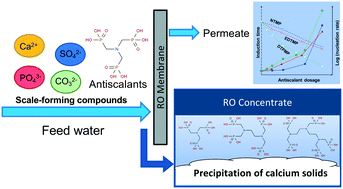Impacts of antiscalants on the formation of calcium solids: implication on scaling potential of desalination concentrate†
Abstract
Brackish water desalination has become increasingly important in arid inland regions for reliable water supplies, but the management of desalination brine waste is costly. In particular, the presence of oversaturated calcium as scale-forming compounds in the brine is challenging to disposal. This study investigated the effects of three widely used antiscalants, i.e., nitrilotri-methylenephosphonic acid (NTMP), ethylenediaminetetra-methylenephosphonic acid (EDTMP) and diethylenetriaminepentakis-methylphosphonic acid (DTPMP) on the precipitation of calcium from solutions under chemical conditions relevant to brackish desalination brine, with an emphasis on the nucleation and precipitation of three calcium-containing solids including hydroxyapatite Ca5(PO4)3OH(s), gypsum CaSO4(s), and vaterite CaCO3(s). The nucleation rates and activation energy of nucleation were investigated for the first time for hydroxyapatite relevant to a desalination concentrate. Results showed that all three antiscalants exhibited uniquely time-dependent effects on the inhibition of calcium solid formation. The precipitation kinetics exhibited a three-phase behavior, with an induction phase, a rapid reaction phase, and a final equilibrium phase. The effectiveness of antiscalant in delaying calcium precipitation and slowing down the rate of precipitation followed the order of DTPMP > EDTMP > NTMP. Antiscalants adsorb on the nuclei of calcium solids and inhibit the crystal growth process. Activation energy of nucleation increased linearly with antiscalant dosage, but it decreased as the regime changed from homogeneous to heterogeneous nucleation. This study generated vital information on the precipitation kinetics of calcium solids in the presence of phosphonate-containing antiscalants and advances the development of desalination brine management strategies.



 Please wait while we load your content...
Please wait while we load your content...